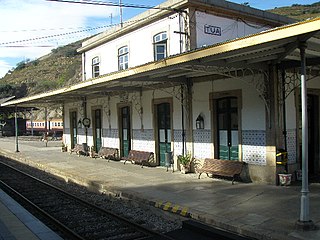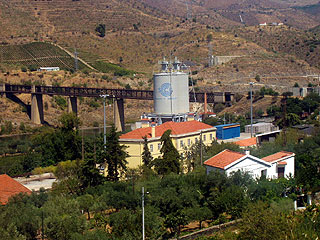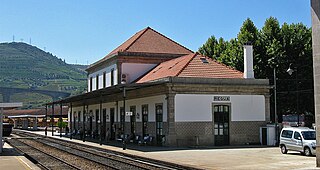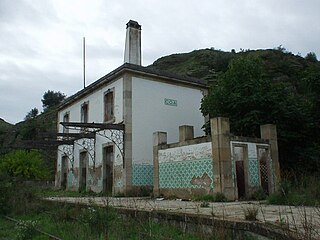
The Douro is the largest river of the Iberian Peninsula by discharge. It rises near Duruelo de la Sierra in the Spanish province of Soria, meanders briefly south, then flows generally west through the northern part of the Meseta Central in Castile and León into northern Portugal. Its largest tributary is the right-bank Esla. The Douro flows into the Atlantic Ocean at Porto, the second largest city of Portugal.

CP — Comboios de Portugal, EPE is a state-owned company which operates passenger trains in Portugal. Prior to June 2009, CP stood for Caminhos de Ferro Portugueses although the company has been using its current designation as a brand name since 2004.
The CP Urban Services network is the commuter train network of Metropolitan Lisbon and Metropolitan Porto, Portugal. It is a Comboios de Portugal company. It connects the city centers with the suburbs.
Ermesinde is a civil parish in the municipality (concelho) of Valongo, in continental Portugal, 9 kilometres (5.6 mi) northeast of Porto. The population in 2011 was 38940, in an area of 7.65 km2. It is the smallest by area, and the densest by population.

The Tua Railway Station is a railway station located in the civil parish of Castanheiro do Norte e Ribalonga, in the municipality of Carrazeda de Ansiães, close to the confluence of the Douro River and the Tua River. The station is served by Comboios de Portugal (CP) main line trains on the Douro line to/from Porto.
Carviçais is a parish of the municipality of Torre de Moncorvo in the district of Bragança (Portugal). The population in 2011 was 757, in an area of 63.00 km². The parish is composed of 7 villages: Carviçais, Macieirinha, Martim Tirado, Quinta da Estrada, Quinta das Pereiras, Quinta das Peladinhas and Quinta da Nogueirinha.

The Tua line was a metre gauge railway line in northern Portugal, which connected Tua to Bragança. The line was opened in 1887 and closed in 2018. The section from Mirandela to Brunheda is planned to be reopened in 2019.

The Corgo line(Portuguese: Linha do Corgo) was a 1,000 mmmetre gauge railway line in northern Portugal. It closed in 2009. It ran north from Régua to Vila Real and Chaves. The line was latterly operated by Comboios de Portugal.

The Tâmega line(Linha do Tâmega) was a 1,000 mmmetre gauge railway line in northern Portugal. It closely followed the course of the Tâmega River. It closed in 2009.

The Sabor line(Linha do Sabor) was a 1,000 mmmetre gauge railway in north-east Portugal. It ran for nearly 106 km between Pocinho and Duas Igrejas, near Miranda do Douro. It closed in 1988.

Portugal formerly had several hundred kilometres of narrow-gauge railways, but by 2010 only two lines were still in operation – the Vouga line and the Metro de Mirandela. The lines were operated by Comboios de Portugal and maintained by REFER.

The Barca d'Alva–La Fuente de San Esteban railway is a closed Iberian gauge line which connected the Barca d'Alva railway station on the Douro line in northeastern Portugal to the Spanish railway network. Passenger and cargo trains ran from Porto to Salamanca from its opening in 1887 until its closure on the Spanish side in 1985, with the Portuguese side also subsequently truncated to Pocinho three years later.
Infraestruturas de Portugal, S.A. (IP) is a state-owned company which resulted from the merger of Rede Ferroviária Nacional (REFER) and Estradas de Portugal (EP). It manages the Portuguese rail and road infrastructure.

The Régua railway station previously known as Regoa railway station, is a station on the Douro Line, which serves the town of Peso da Régua, in the District of Vila Real, in Portugal. It opened in 1879, and served as a junction point with the Corgo Line, which operated between 1906 and 2009.

Barca d'Alva is a Portuguese village located in the municipality of Figueira de Castelo Rodrigo, north of the Guarda District. Barca d'Alva is also located inside the Douro International Natural Park and less than 1 km away from the Portugal-Spain border, defined by the Douro and the Águeda rivers.

Pocinho railway station is located on the Iberian gauge Douro line, which serves the town of Pocinho, in the municipality of Vila Nova de Foz Coa, in northern Portugal. It also served as a junction with the Sabor line from its opening in 1911 until its closure in 1988. Since 1988 the station has been the terminus of the Douro Line, following the closure of the section that extended to Barca d'Alva and the Spanish border. There have been calls for this section to be reopened.

Barca d'Alva railway station was the terminal station of the Douro Line, until its closure in 1988. The station used to serve Barca d'Alva and acted as a border station between Portugal and Spain, via the Barca d'Alva–La Fuente de San Esteban railway. It is located in the municipality of Figueira de Castelo Rodrigo, in Portugal.

The Coa halt, is a closed interface of the Douro line, which used to serve the town of Vila Nova de Foz Côa, in the Guarda District, in Portugal. The halt started operating on 5 May 1887, and was closed in 2 October 1988.

La Fuente de San Esteban-Boadilla is a railway station located in the Spanish municipality of La Fuente de San Esteban, in the province of Salamanca, autonomous community of Castilla y León. It has no passenger services, although it can be used as a switch for crossing trains. Historically, the La Fuente de San Esteban-Boadilla station was a railway junction of some importance, where the Medina del Campo-Vilar Formoso and Barca d'Alva–La Fuente de San Esteban lines converged, both of international character. As a result, it had considerable passenger and freight rail traffic, as well as a number of large-scale facilities. The closure of the line to Barca d'Alva in 1985 meant that the station lost its importance, the situation got worse when the Barca d'Alva railway station closed in 1988.


















